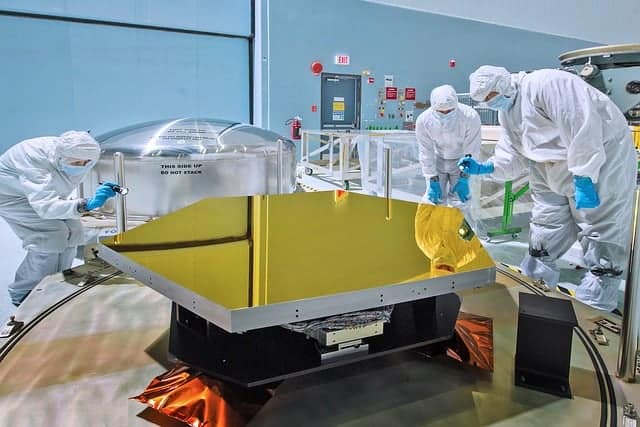The James Webb Space Telescope, also known as JWST or Webb, is mostly an infrared telescope that is set to be the successor of the Hubble Telescope as the premiere observatory that is used by thousands of astronomers worldwide.
Some Back Story
In 1929, an astronomer named Edwin Hubble had made a discovery that would shock the world of astronomy and physics. While working at the Carnegie Observatories in Pasadena, California, he measured the redshift of the light from distant galaxies.
Redshift is the phenomenon where the wavelength of light from any source gets stretched out as it travels through space. He found out that the redshift of distant galaxies increased with their distance from Earth. The only explanation for this observation is that the universe is expanding. This is a shock because physicists and astronomers at that time, including Albert Einstein himself, believed that the universe is static and unchanging.
In honor of Edwin Hubble and his discovery of the expanding universe, the Hubble Space Telescope was named after him. It would then become the largest space telescope at the time of its launch and an essential research tool for astronomers and physicists alike.
Since Hubble was launched in 1990, it has helped resolve some long-standing problems in astronomy, while also raising new questions. Today, NASA has already laid out plans to launch an even more advanced and powerful telescope into orbit, which is the James Webb Space Telescope.
James Webb
The James Webb Space Telescope, also known as JWST or Webb, is mostly an infrared telescope that is set to be the successor of the Hubble Telescope as the premiere observatory that is used by thousands of astronomers worldwide.
It will have a 6.5-meter diameter primary mirror, which gives it a much larger collecting area than those available on the current generation of space telescopes. For comparison, the Hubble telescope has a primary mirror that is 2.4 meters in diameter. This would also translate to Webb having 6.25 times more collecting area.
Why Do They Use Infrared Telescopes?
The universe is filled with clouds, dust and gases, mostly called nebulae. The problem with nebulae is that they absorb visible light which makes it harder for telescopes to see objects behind them. Infrared light, however, is unaffected by these which is why infrared telescopes are more useful in astronomy.
Another reason is because of redshift. As we have already discussed, the expanding universe stretches the wavelengths of light from distant galaxies. The light that is coming from very distant sources would already have been stretched to infrared wavelengths as they reach the Earth.

Also, because of the time it takes light to travel, the further away any object is, the farther back in time we are seeing. Based on the amount of time the light took to reach our eye. With infrared telescopes, not only can we look farther in space, but we are also are able to observe the first stars and galaxies that formed just a few hundred million years after the Big Bang.
What Is the Mission for the Telescope?
Webb’s mission or science mandate is principally divided into four areas:
- Study of the Early Stages of the Universe – Webb aims to collect data from the early stage of the universe known as First Light and Reionization. During this time, atoms have not yet formed, and there was still no visible light. The universe was filled with a sea of particles such as electrons, protons, and neutrons. The light was unable to travel freely, as they were scattering off free electrons. As the universe continued to expand, the universe cooled which allowed these particles to combine into ionized atoms of Hydrogen and form the first atoms. The light was also able to travel freely for the first time.
- Looking for the Earliest Galaxies – one of Webb’s goals is to look back and observe the earliest galaxies in the universe to try to understand how they form and how the universe evolved as a whole.
- Observe How Stars are born – stars come to be in clouds of gas. With Webb’s infrared telescope, it would be much easier to see inside these gases and observe how stars are created and born.
- Finding Planets that are Capable of Supporting Life – along with a more powerful telescope, Webb is also equipped with powerful sensors that will also be able to look at potential planets in more depth. For some cases, it may even be able to image their atmospheres. This is a huge help in finding planets that are supporting life as their atmospheres and their formation conditions are needed to be known so that scientists can better predict if they are habitable or not.
What Wavelength of Light will the Webb Telescope Observe?
Webb will primarily observe infrared light with a wavelength coverage of 0.6 to 28 micrometers (or “microns”; 1 micron equals 1.0 x 10-6 meters). It is also equipped with four science instruments, a near-infrared camera, a near-infrared spectrograph, mid-infrared instrumentation, and a near-infrared imager and slitless spectrograph. These instruments can be used to capture images and spectra of different celestial bodies.
Why Have There Been Delays in Launch?
Webb was initially scheduled to be launched sometime around 2007 with an initial budget of $1 billion. On October 2011 but it was announced on June of this year that its launch will be delayed to March 2021. The project cost has also ballooned to more than nine times as much, around $9.66 billion.
One of the causes of the delay of this project is specific human errors by the project’s primary contractor, Northrop Grumman. A few examples of these errors are: Incorrect solvent was used to clean a fuel valve, and someone applied the wrong voltage during a test.
Many experts argue that the blame for the project’s woes has started even in the planning phase. They say that because Webb is so advanced compared to telescopes that are available at that time, NASA never really had true estimates from the start relating to how much it was going to cost or how long it was going to take.
This is not uncommon, however, given another example, the Hubble Space Telescope was initially projected to cost $200 million but ultimately cost at around $1.2 billion.
How Long Will It Take to Get the First Images from Launch Date?
There are many things that the telescope must first be able to achieve before it can become fully operational and get its first images. After its launch, it will need around one month for it to get to its desired observing position. After this, the instruments will then have to be left to cool to temperatures close to absolute zero. Any remaining heat introduces noise to the captured images, and the telescope will not be able to work correctly with them.
Finally, when Webb has cooled, the instruments in it will be adjusted and properly calibrated. All of these processes are expected to take 180 days. This means that it will take at least 180 days after its launch when Webb will finally be able to make its first images.
Why is the James Webb Space Telescope so Important?
The James Webb, Space Telescope project, has been plagued by many problems such as poor management and exceeding the expected budget. However, the project has been continued because of its significance to astronomy and opening up more understanding of the universe.
We have been rapidly approaching the limit of what can be done and discovered scientifically with just using the Hubble and other available telescopes. The Webb opens up more doors in astronomy for areas that we can observe and study to further our understanding of the universe and its creation.
So, Is It Worth It?
That all depends on your prospective of course, but lets look at it this way. While 10 billion dollars sounds like a lot to us individuals, it is chomp-change when you look at the whole US budget.
The 2020 budget is proposed to have a revenue of 3.645 Trillion dollars. Out of that Americans paying income tax on their wages alone is estimates at 1.824 Trillion.
Let us convert the trillion to billion and do the math. The Webb Telescope is currently rounded to 10 billion. Divide the 10 billion by the Income tax revenue alone in 2020 being 1,824 billion. That equals 1/2% of Americans income going to something that could open our human eyes. As a matter of fact Webb;s cost could increase to 18.6 Billion until the telescope would be 1% of the revenue from Americans paying in taxes in 2020.
Divide that over the years that the telescope has been planned and built even more greatly reduces the financial burdens. Other countries have helped chip in as well. I think the delays make people question the ideal of the Webb, but it still leaves us to the question; is it worth it?
I believe that it is well worth the cost, as long as it gets to space and works once it is there. Before Hubble we were happy with our back yard, but wondered what and how. Post Hubble, we still have the questions of What and How, but our back yard became so much larger. Even though we have learned so much more from increasing our yard as it were, we still have questions. It is just human nature to find out; what is out there?
To learn more on how you can use your own telescope to see the universe check out this article on 30 quick telescope tips and tricks.


